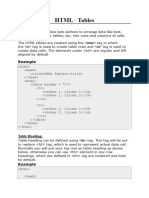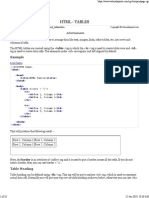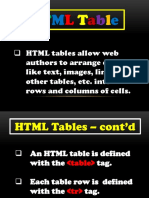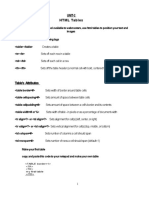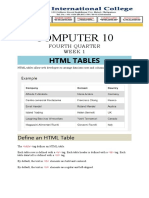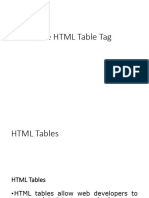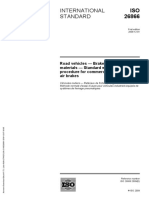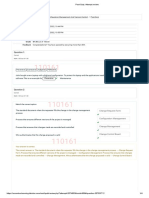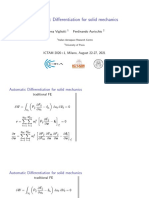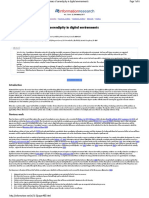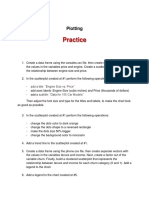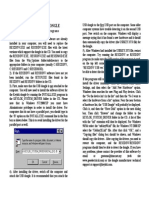NOTES
Tabl
einHTML
� NOTES
Introduction to the Table
A table is a structural data set of rows and columns. A table allows
you to quickly and easily look up values that indicate some kind of
connection between different types of data.
For example: Storing tabular data like a person's age, a day of the
week, or the timetable for a local swimming pool.
Let's understand with a simple example.
Suppose, we want to display the above table in HTML. To construct
tables in HTML, we use <table>, <tr>, <th>, and <td> tags.
Now let's understand all the table tags and create the above table
step by step.
● <table>: The content of every table is enclosed by these two
tags <table></table>
● <td>:
1
� NOTES
The smallest container in the table is a table cell, which we
can create by using the <td> tag which denotes table data.
Example: Create multiple table data cells <td> and also add
borders using table tag border attribute.
JavaScript
<table border="1">
<td> john </td>
<td> 25 </td>
<td> New York </td>
</table>
Browser output:
You can see that the data cells are not placed under each other,
They are automatically aligned with each other on the same row. <td>
create one single cell and together they create one-row. And the border
attribute in HTML tables specifies the width of the border around table
cells.
It's worth noting that the use of CSS's border property is generally
preferred over the border attribute for greater control and flexibility in
styling. We will be learning the css border property in the css section.
● <tr> : This element defines a row of cells in a table
2
� NOTES
JavaScript
<table border="1">
<tr>
<td>john</td>
<td>25</td>
<td>New York</td>
</tr>
<tr>
<td>Jane</td>
<td>30</td>
<td>Los Angeles</td>
</tr>
<tr>
<td>Michael</td>
<td>22</td>
<td>Chicago</td>
</tr>
</table>
Browser output
● <th>: This tag defines a header cell in an HTML table. The
text in <th> elements are bold and centered by default.
JavaScript
<table border="1">
<tr>
<th>Name</th>
<th>Age</th>
<th>city</th>
</tr>
<tr>
3
� NOTES
...
</tr>
<tr>
...
</tr>
<tr>
...
</tr>
</table>
Browser output:
To create the designation section and the footer section of the
table, we have to use the “rowspan” and “colspan” attributes,
respectively.
“rowspan”:
This attribute allows a cell to occupy and cover multiple rows,
making it taller than a single row which means spanning a cell
against several rows. To use rowspan, we need to include this
attribute within <td> or <th> of the cell you want to span multiple
rows. The value of rowspan specifies how many rows the cell
should span.
Now let's add the designation header and fourth cell(“td”) of the
second row(“tr”), which cover the last three rows,
4
� NOTES
JavaScript
<table border="1">
<tr>
<th>Name</th>
<th>Age</th>
<th>city</th>
<th>Designation</th>
</tr>
<tr>
<td>john</td>
<td>25</td>
<td>New York</td>
<td rowspan="3">developer</td>
</tr>
......
</table>
Browser output
“colspan”: This allows a cell to span across multiple columns, making
it wider than a single column which means spanning a cell against
several columns. To use colspan, we need to include this attribute
within <td> or <th> of the cell you want to span multiple columns.
The value of colspan specifies how many columns the cell should
span.
Let's create the footer for the table by adding one row (“tr”) at the
bottom of a table whose cell (“td”) occupies four columns.
5
� NOTES
JavaScript
</table border="1">
....
<tr>
<td colspan="4">team of three developers </td>
</tr>
</table>
Let’s give some padding to each cell(“td”) by using cellpadding
attribute
cellpadding”:
creates a gap between content and cell borders, making the table
look tidier and easier to read.
JavaScript
<table border="1" cellpadding="10">
<tr>
<th>Name</th>
<th>Age</th>
<th>city</th>
<th>Designation</th>
6
� NOTES
</tr>
......
</table>
The cellpadding attribute is set to 10, which means there will be 10
pixels of space between the content inside each cell and the cell
borders. You can adjust the value to control how much space you
want between the content and the cell borders.
Browser output:
We can also add space between the table cells(“td”) by using
Table attribute called cellspacing.
cellspacing:
This attribute specifies the amount of space we want between the
cells of the table.
7
� NOTES
JavaScript
<table border="1" cellpadding="10" cellspacing="10">
<tr>
<th>Name</th>
<th>Age</th>
<th>city</th>
<th>Designation</th>
</tr>
......
</table>
cellspacing attribute is set to 10, which means there will be a 10-pixel
gap between all the cells of the table. You can adjust the value to
control how much space you want between the cells.
Browser output
● <caption>: <caption> tag in HTML is like a title for a table. It goes
right after the <table> tag but before the data rows. It helps explain
what the table is about, making things clear for people who see it.
8
� NOTES
Think of it as a label that makes your table organized and easy to
understand.
JavaScript
<table border="1" cellpadding="10" cellspacing="10">
<caption>Web dev team</caption>
<tr>
<td>john</td>
<td>25</td>
<td>New York</td>
</tr>
<tr>
<td>Jane</td>
<td>30</td>
<td>Los Angeles</td>
</tr>
<tr>
<td>Michael</td>
<td>22</td>
<td>Chicago</td>
</tr>
</table>
Output:
<thead>, <tbody> and <tfooter>:
9
� NOTES
As you can see, we created the same table as shown in the
introduction. Let's structure the content in the table using <thead>,
<tbody> and <tfooter>.These elements are used to provide semantic
meaning to different parts of the table.
JavaScript
<table border="1" cellpadding="10" cellspacing="10">
<caption>Web dev team</caption>
<thead>
<tr>
<th>Name</th>
<th>Age</th>
<th>city</th>
<th>Designation</th>
</tr>
</thead>
<tbody>
<tr>
<td>john</td>
<td>25</td>
<td>New York</td>
<td rowspan="3">developer</td>
</tr>
<tr>
<td>Jane</td>
<td>30</td>
<td>Los Angeles</td>
</tr>
<tr>
<td>Michael</td>
<td>22</td>
<td>Chicago</td>
</tr>
<tr>
<td colspan="4">team of three developers </td>
</tr>
</tbody>
</table>
10
� NOTES
Output:
11
� www.
aimer
z.ai
THANK YOU
Vi
shwaMohan Vi
shwa.
mohan.
singh Vi
shwaMohan Vi
shwaMohan






